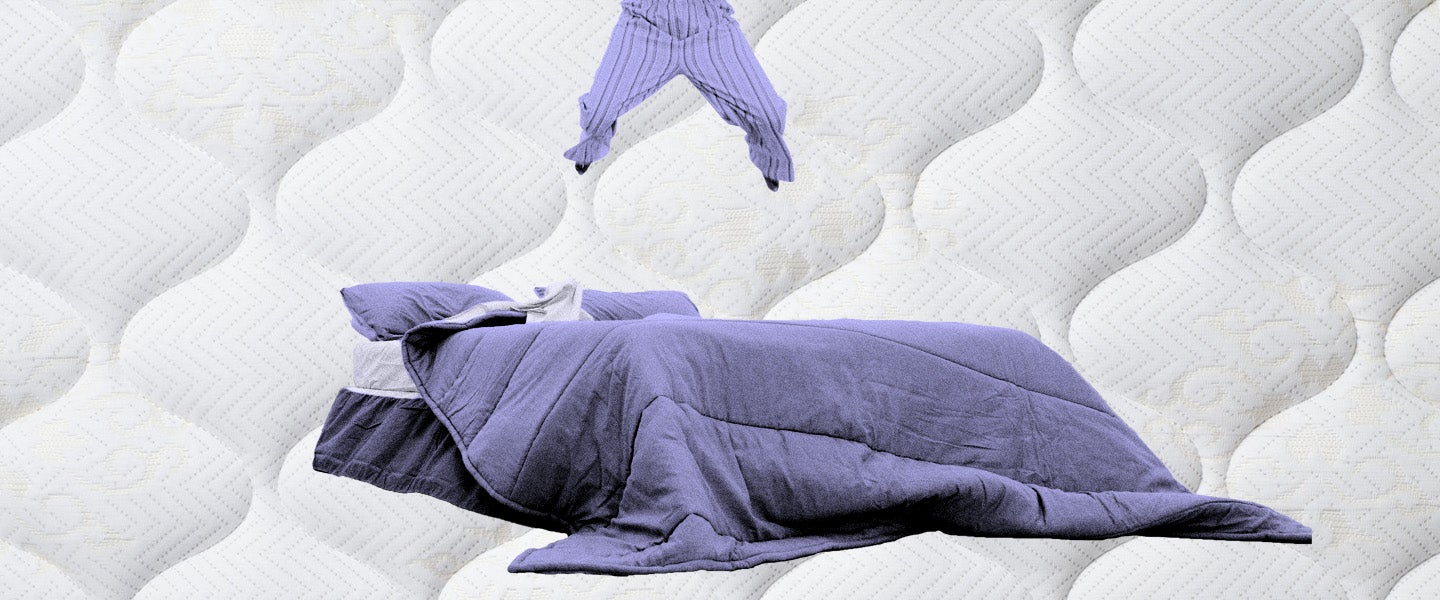Spending a good chunk of money on a mattress is obviously a wise investment. You spend a third of your life asleep, or if you’re like me, more than half of your life at least reclined on a mattress. As with cars, toilet paper and cuts of meat, purchasing the cheapest mattress likely will not serve you well.
But here’s the thing: I’m 23. You cannot possibly convince me to spend more than my monthly student loan payment on a slab of foam and cotton. Not even those millennial-marketed podcast-subsidizing “bed-in-a-box” companies like Casper or Purple are on my radar, never mind the legit brands like Serta. Say I had to move across the country in a year: What the fuck am I gonna do with my expensive-ass mattress? Pay even more money to transport it? No! I’m gonna toss my $200 Amazon mattress in the trash and make the same mistake all over again in a new city.
I know I should buy a higher quality mattress. But I’m not going to. I will, however, spend a little extra on some added details that make my shitty mattress seem adequate, at least.
I May Be Trash, But I’m No Frat Boy
Just because you bought the bare-minimum mattress doesn’t mean you have to do the bare minimum with it. At least give yourself the semblance of togetherness by purchasing a bed frame. Box springs are honestly optional (as a matter of personal opinion, but many manufacturers will demand that a mattress is kept on the box spring in their warranties), getting the mattress off the ground, however, is not.
This is both a practical and aesthetic matter. For one, it obviously just looks way better. Nothing screams “I will disappoint you emotionally, sexually and spiritually” like a mattress on the floor. But more than that, bed frames can give your mattress more support and help it last longer by keeping it cleaner. On the floor, there’s nowhere for dirt, dust and dead skin cells to go. With a bed frame, air can flow beneath the mattress. This is also important for mold and insect control — you might be cheap, but you can still be clean. Even the cheapest frame you can find (like this metal one on Amazon for $35) or a thrifted version will do the trick.
The Comfort Stuff
In terms of making your mattress more comfortable, you have a lot of options. What works best for you will depend on your preferences, and it’s possible to go overboard — too many extra layers of cushioning could actually make a bed even more uncomfortable. But there are mattress toppers for just about every taste, so whether you’d like your bed to be softer or firmer, there’s a topper for that.
While mattress toppers can sometimes cost more than the mattress itself, there are plenty of solid options under $50. If you’re looking for a major improvement, particularly when trying to make your mattress more firm, you might be better off spending closer to $100, though. At this price range, you can get a memory foam pad that will add a few inches to the height of your mattress. But if you’re more into fluffiness than firmness, you can get a quilted, down-alternative-filled mattress pad for somewhere around $30.
I recommend checking out T.J. Maxx, Marshalls or HomeGoods for these types of products, as well. There are usually a dozen or so different choices at a deeper discount than on Amazon, often with some more familiar brands.
The Final Fancy Details
Like a bed frame, a fitted sheet on your mattress is an absolute necessity. If I went home with a man and he didn’t have a fitted sheet on his bed, I’d leave. More than anything, it’s hygienic –– you can’t toss your mattress into the washer every few weeks like you can a sheet.
The right sheets, blankets and pillows can also add a lot to the comfort and fanciness of your sleeping experience. If you run hot in your sleep or find yourself waking up because you’re cold, the material of your bedding might be playing a major part. If you’re too cold, you probably should just add a blanket. But if you’re too hot, try cotton or other natural fiber-based sheets and comforters. One hundred percent cotton is often more expensive than synthetic options like microfiber, but you can usually find high-quality cotton sets at places like T.J. Maxx, too. If the temperature isn’t an issue, cheap sheet sets are often just as comfy and attractive as the more expensive ones. A clean set of (matching!) sheets will go a long way, even if you only spend $25.
Ditto for your comforter. For ease of cleaning, a duvet cover can be convenient. I’ve found it also makes things feel a bit more plush. As for pillows, figure out what you like in terms of firmness and search from there. There’s not much need to spend more than $15 to $20 per pillow, unless you need a particular type of pillow for back pain. I was given some fancy goose down pillows, and you know what? I barely even sleep on them. They’re finicky, as seems fitting for a pillow made of goose feathers.
Now Sleep, Sweet Angel
All said and done, you could totally revamp your mattress for under $100 if you really tried, frame included. The extra layer of foam, the softness of your new sheets and the added feng shui of airflow beneath your mattress should help you forget that you spent like, $180 on your mattress. If anything, it’ll at least help you feel a little more like you have your shit together. Considering I’m most often kept awake at night by the dread of propelling through this mortal coil, that counts for a lot more than you might think.

